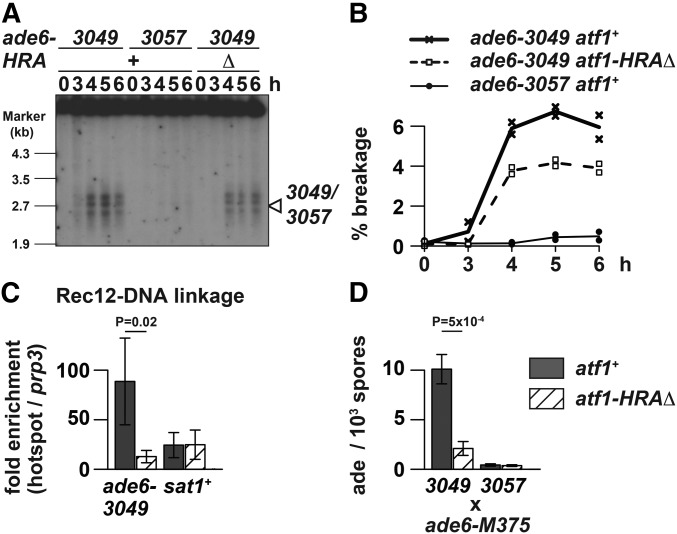Figure 3.
Deletion of the Atf1 HRA region affected meiotic recombination at ade6-3049. (A) Effects of HRA deletion on DSB formation at the ade6-3049 hotspot. Indicated cells of the pat1-114 rad50S background were induced to enter meiosis by temperature-shift method, and harvested at the indicated hours after the induction. Genomic DNA was isolated, digested with Afl II, and analyzed by Southern blotting as previously described (Steiner et al. 2002). The position of the 3049 or 3057 mutations is marked by the arrowhead. (B) Quantitative analyses of DSB formation presented in (A). The DSB (%) values were obtained by dividing the signal intensity of broken DNA fragments over that of the unbroken parental fragment. Mean values of two independent experiments are plotted. (C) Effects of HRA deletion on Rec12-DNA linkage production at the ade6-3049 hotspot. Rec12-FLAG-expressing pat1-114 rad50S strains with or without HRA were induced to enter meiosis by temperature-shift method, and harvested 5 hr after the induction. Rec12-FLAG-DNA linkage was chromatin immunoprecipitated by anti-FLAG antibody. DNA isolated from immunoprecipitates and whole-cell extracts was analyzed by real-time qPCR, where fragments corresponding to the hotspots (ade6-3049 and sat1) and the prp3+ promoter (prp3) were amplified. Relative enrichment at hotspots over prp3 was calculated and mean values of three independent experiments as well as their SD are shown. (D) Effects of HRA deletion on meiotic gene conversion at the ade6-3049 hotspot. Recombination frequency was measured between ade6-M375 and either ade6-3049 or ade6-3057 by counting the number of ade+ spores. Mean values of three independent experiments and their SD are shown.

